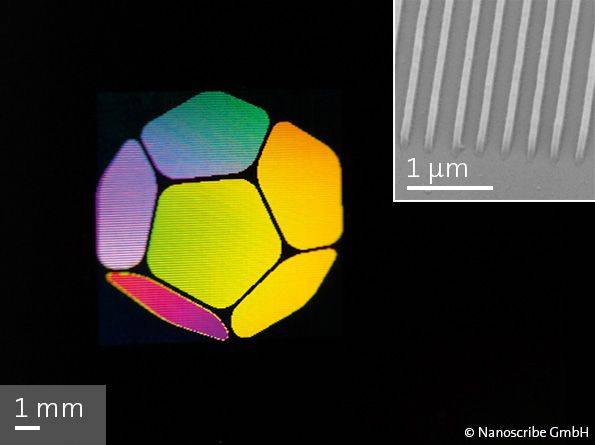[ihc-hide-content ihc_mb_type=”show” ihc_mb_who=”reg” ihc_mb_template=”3″ ]
[vc_row][vc_column][vc_column_text]Credits: www.3dprintingindustry.com
Working with two-photon lithography, i.e. 3D microprinting, Nanoscribe has developed a new method for creating microscopic security features.
A microscope on two-photon lithorgaphy
In two-photon lithography a pulsed laser is used to solidify a photoreactive material in a series of layers. The size of the laser’s focal spot is so fine that it is capable of 3D printing objects that could fit onto the tip of a pencil, or be injected into the body.
For security tags, Nanoscribe scientists make what is called multi-level diffractive optical elements (DOEs) – a name derived from how features in the 3D printed object split and direct light to make an image.[/vc_column_text][vc_single_image image=”2959″ img_size=”full” add_caption=”yes” alignment=”center”][vc_column_text]DOEs are usually made using a photomask, which contains the “to-be-printed” pattern. The process of making this mask is lengthy and expensive. By cutting out the middle man, two-photon lithography is a maskless method of 3D microprinting which is quick and cost-effective.
From serial numbers to peacock spiders
In the process a design, such as a company logo or serial number, is loaded into the computer as a bitmap image. Containing pixel-like data of the image to-be-printed, the bitmap is fed directly to a Photonic Professional GT lithography system.
The finished product is a microscopic cluster of dots or lines that create a 2.5D projection when hit with a laser.[/vc_column_text][vc_single_image image=”2960″ img_size=”full” add_caption=”yes” alignment=”center”][vc_column_text]As a relatively low-cost solution, two-photon lithography can be used to test new security prototypes, or create a master mold for mass-manufacturing multiple products.
This technique was recently used to discover how peacock spiders change color, and is also integral to efforts improving fiber-optic communications.
Nanoscribe will be demonstrating this latest two-photon application at Photonics West annual conference run by SPIE (the international society for optics and photonics) from 30th January – 1st February 2018.[/vc_column_text][/vc_column][/vc_row]
[/ihc-hide-content]
The AM Chronicle Editorial Team is a collective of passionate individuals committed to delivering insightful, accurate and engaging stories to additive manufacturing audiences worldwide.



